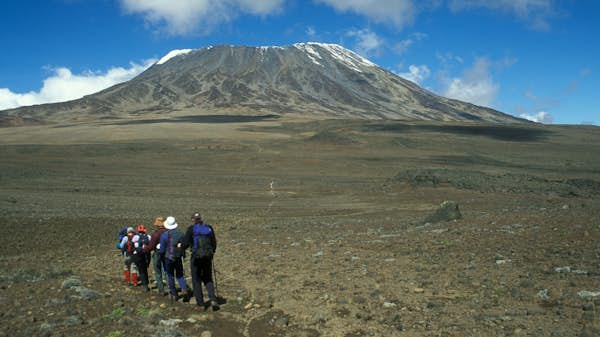Astonishing wildlife, sand-dusted beaches, idyllic tropical islands, vibrant markets and a rich cultural tapestry – Tanzania embodies the best of Africa, with well-established tour and safari companies waiting to whisk you to the top of Kilimanjaro or the bottom of the Ngorongoro Crater.
Tanzania brings travel dreams to life. Imagine yourself basking on the beaches of Zanzibar or watching vast herds of wildebeest roaming across the Serengeti. Picture sharing the sunset with a family of elephants silhouetted against a baobab tree in Tarangire National Park, or watching sunrise from the summit of Kilimanjaro. The only limits to the experience are your budget, timeframe and ambition.
Whatever you’re hoping to do in Tanzania, it pays to heed the climate and the seasonal migration patterns of the local wildlife. Here’s our guide to the best times to visit this wonderful East African nation, with tips on everything from catching the great migration across the Serengeti to the country’s best festivals.

June through September is the best time for wildlife-watching
The period from June to September is Tanzania’s cooler, drier high season. Vast herds of wildebeest begin hoofing it northwards on their migration towards the greener grasses of Kenya’s Masai Mara, the lower slopes of Kilimanjaro are mostly mud-free, and Zanzibar’s beaches beckon under sunny skies. Overall, it’s a wonderful time to travel, with the only real downsides being peak prices and crowds.
In July and August, as the dry season progresses, animals begin to concentrate around dwindling water sources and vegetation becomes more sparse. With less cover, wildlife gets easier to spot and the safari season reaches its annual peak, though this can mean crowds of safari vehicles in some national parks.
Beyond the Serengeti, southern Tanzania’s Ruaha National Park is full of elephants, buffaloes, kudu and other species. Over in western Tanzania, you can see massive pods of hippos fighting for space around the few remaining mud wallows in Katavi National Park. If you’re here to see primates, the chimpanzees of Gombe National Park and Mahale Mountains National Park move lower down the steep slopes, and tracking them is usually easier.
The dry season is also the ideal time for trekking to the summits of Mt Kilimanjaro and Mt Meru, and for hiking in northeastern Tanzania’s Usambara Mountains. On the coast, temperatures and humidity are somewhat lower and the islands are crowded, but delightful.
This is the busiest time for tourism in Tanzania and it’s essential to book in advance, especially for safaris, Kilimanjaro treks and island getaways.

October to February brings great birding and fewer crowds
In October, the start of Tanzania’s shoulder season, the weather stays sunny and mostly dry, making this another fine time for wildlife watching, particularly for birdlife. Parks such as Tarangire are at their best in the late dry season, and you’ll see only a fraction of the high-season crowds.
October also brings Tanzania’s jacaranda trees into bloom, especially in the north around Moshi and Arusha, and in the southwest around Mbeya. It’s a magnificent feeling to stroll beneath their purple canopies on a carpet of lavender-hued blossoms.
In November, as the short rains get underway, the Tanzanian mango season begins. Look out for buckets of ripe fruit being sold along the roadside from late November. This is also the start of peak birding season, as the first of the migrant species begin arriving from the north.
During the Christmas and New Year’s holidays – from mid-December to the first week in January – prices temporarily skyrocket, but on each side of this window, many lodges and camps offer reduced shoulder-season rates.
The hottest temperatures of the year generally hit in February, especially along the coast, but birding is excellent countrywide and the southeastern section of the Serengeti is full of activity, with the wildebeest calving season in full swing. February is also the best month to view the orchids in Kitulo National Park, and for admiring the surrounding highlands, which are blanketed with wildflowers.
In northern Tanzania, the warm, dry period between December and February is ideal for Kilimanjaro treks. On the coast, the shoulder season months are optimal for spotting whale sharks, which migrate past Mafia Island from October to March.

March to May is the time for lush green landscapes and low prices
Mid to late March marks the start of Tanzania’s main rainy season and heavy downpours turn roads and hiking trails to mud. Many lodges close, especially on the coast and along the southern and western safari circuits, and those that do stay open often offer significant discounts.
Yet, despite the wet, there’s still plenty of sunshine, and if your focus is on getting to know Tanzania’s diverse cultures, and exploring away from the crowds, this can be a rewarding time to visit. Landscapes across the country are brilliant green and visitor numbers are at their lowest.
Between late April – when the rains begin to taper – and early June, the wildebeest start their long migration northwestwards from their calving grounds in the southeastern Serengeti towards the Kenya border, and brightly-hued birds are easy to spot (with males often resplendent in their colorful breeding plumage).
Anytime is festival time in Tanzania
No matter when you travel to Tanzania, there’s likely to be a festival or event happening somewhere in the country. Early February brings the Sauti za Busara festival to Zanzibar, filling the island with music and art, while late February is the time for the community-oriented Kilimanjaro Marathon in Moshi.
Back in Zanzibar, make time for the Zanzibar International Film Festival – held in early August in 2024. The Mwaka Kogwa festivities, marking the Shirazi (Persian) New Year, bring a joyful mood to Zanzibar in late July. A highlight on the mainland is the Bagamoyo Festival of Arts and Culture, held in the town of Bagamoyo, usually in October.

